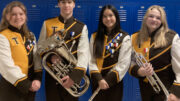MEADVILLE (AP) — An underwater robot will be roaming Presque Isle Bay to collect water quality data beginning this spring.
The robot doesn’t look impressive.
It looks like the plumbing under your sink.
Built largely of PVC pipe, it cost less than $100 to make.
But looks aren’t everything.
The robot built by David Boughton of Pennsylvania Sea Grant will carry sensors programmed by Allegheny College computer science professor Janyl Jumadinova and student Elisia Wright.
The sensors will gauge water temperatures, pH levels, oxygen content and conductivity — “the essential metrics for water quality,” Jumadinova said — at various locations and depths.
The remotely-operated robot will collect a range of data over hours rather than individual random samples.
“The end game is to put the sensor system onto the robot that can travel in water collecting data, rather than working manually with one sensor and then collecting data from that,” Jumadinova said.
“It’s adding mobility to our Hydrolab,” Boughton said, “which is dropped in the water tethered to a hand-held computer.”
The robot also will provide data at speed and can simultaneously analyze the data and store it to help keep tabs on the health of Presque Isle Bay. The information it collects will be shared with other researchers.
The robot also can provide data for students to interpret.
Boughton teaches Crawford County middle school students to build submersible robots in a weekly class in the basement laboratories at Allegheny’s Alden Hall. The students will go out on Presque Isle Bay aboard the Gannon University research vessel Environaut to test water quality this spring.
“It’s upping our game in education,” Boughton said of the robot. “We’ve shown students how to acquire data in the past. Interpretation of that data always has been beyond our time and reach.”
College students also can benefit from Boughton’s robot, Jumadinova said.
“We can bring analytics students into this to figure the best way to analyze the environmental data,” she said. “The college also has robust environmental studies and science programs that also are interested in this and could benefit from the data as well. There’s potential for a number of our students to plug in and do some work on this.”
The underwater robotics project is almost tailor-made for one Allegheny College student.
Wright, 19, of New Jersey, is a dual computer science and environmental studies major working with Jumadinova on the programming and software to accommodate the robot’s environmental missions.
“It combines both my major interests,” she said.
The robot engineering and programming partnership grew out of an Allegheny College-Crawford Central School District S.T.E.M. — science, technology, engineering and math — partnership between college instructors and public school teachers.
Boughton is a maritime education specialist with Sea Grant, which is led by the Pennsylvania State University. In addition to the underwater robotics course at Allegheny, he teaches robotics and environmental courses in schools throughout the Erie region and in summer programs on Lake Erie.
“Collaboration is key. Institutions of higher learning and public schools working together can provide greater opportunities for students,” Boughton said.
Boughton’s robot was tested in the pool at Allegheny College’s David V. Wise Sport & Fitness Center this winter.
An earlier prototype of the robot used sensor boards that remained on the surface. The newest model will carry the sensors into the bay in a waterproof container that’s still being designed.
The robot or a cousin can be outfitted and programmed to do more than sample water. It could sample sediment, survey lake shipwrecks and go fishing to count the species inhabiting local waters.
The robots’ appearance also can be tweaked.
Submersibles built by Boughton’s middle school students sport turtle shells or duck decoys.
“Learning needs to be fun, too,” Boughton said.



































